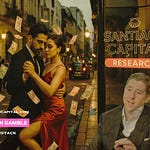Every few years, the dollar is declared dead. Every few years, it refuses to stay buried.
The latest round of dollar obituaries came fast and loud.
A 5% drop in the Dollar Index? Foreigners fleeing U.S. markets? Capital racing back to home shores? It’s the end of the road for the almighty greenback… right?
Not quite.
If the reaction feels familiar, it should.
We’ve seen this movie before… 2008, 2020… and we know how it ends.
The world panics, sells U.S. assets, the dollar dips... and then rallies harder than ever.
Let’s call this what it is: the Milkshake Theory playing out in real time.
The critics are chanting “It’s different this time!” But they always chant that… usually right before it’s exactly the same.
So grab a straw. We’re going to take another long sip from the milkshake.
Welcome to the Milkshake Machine
Over the past month, the markets have looked like a toddler on espresso.
Volatility spiked. The dollar slipped. Trump’s return to the spotlight sent tremors through the global policy arena.
Foreign investors, spooked by the headlines, started selling off U.S. stocks and bonds, repatriating capital like it was the last flight out of Saigon.
The Dollar Index dropped nearly 5% in two weeks.
Cue the chorus: “See! The Milkshake Theory is broken!”
Not so fast.
How could foreigners dump U.S. assets if they didn’t own them in the first place? And how could the dollar fall if it hadn’t already been strong?
This is the Milkshake Theory in action…not its failure.
The U.S. dollar acts like a massive straw, sucking up global capital when times are good.
But when risk hits, some of that capital gets pushed back out, creating a temporary dip. And when true panic sets in?
Everyone dives for dollars.
Just like they always do.
Flashback: 2008, COVID, and Déjà Vu
Let’s roll the tape back to 2008. The Global Financial Crisis.
September 15th: the DXY sits at 80. Two weeks later: 76. Down 5%. Equity markets tank. Foreigners sell U.S. assets to shore up collapsing domestic positions.
Looks familiar, doesn’t it?
And then?
The dollar ripped higher as the world scrambled for dollar liquidity. Why?
Because the U.S. is the world’s piggy bank.
When disaster strikes, everyone cashes out their rainy-day funds. And those funds? They're mostly in dollars.
Or take February 2020. COVID smashes into global markets. The DXY drops from 99 to 94 in two weeks.
Again… a 5% drop.
Again, capital flees.
Again, the dollar comes roaring back.
This is not new. This is the Milkshake. Slurp, pause, slurp harder.
Big Capital Still Lives Here
If you're looking for hard data, let’s talk TIC.
No, not the nervous kind…Treasury International Capital reports.
These show foreign holdings of U.S. securities still clocking in around $27.3 trillion as of late 2024.
That’s not a typo.
And when volatility hits? Sure, some of that gets sold. But the base remains enormous. Why?
Because the U.S. continues to attract capital like a black hole in a universe of shaky alternatives.
Since 2008, the S&P 500 has gained 350%.
Compare that to the MSCI World Index (ex-US), which only managed 150%. And the Dollar Index itself? Up 29% over the same stretch.
This isn’t a bug in the system. It is the system.
Every time we hear “this time is different,” the milkshake gets stronger. But could the next crisis change the ending?
Debt, Liquidity, and the Milkshake Cycle
Now let’s get into the plumbing.
Our global financial system is debt-based. When governments and central banks inject liquidity into the economy… QE, bailouts, whatever… they do so through loans.
That liquidity is short-term soothing, but it creates long-term dollar demand.
Why? Because debt has to be repaid in dollars. Especially dollar-denominated debt.
And there’s a mountain of it.
Global debt has now crossed $315 trillion, according to the IIF, with a big chunk still priced in dollars. So every time central banks add liquidity, they’re also increasing future demand for the dollar.
More milkshake. More straw power.
And when the panic really hits? Dollar demand spikes…because that’s the currency in which bills come due.
QE: The Great Misunderstanding
The skeptics love to point to QE.
“Look at all the money printing!” they cry, as if this should spell the dollar’s doom. But QE is how the global Milkshake gets made. And what matters most is who then gets to drink it.
So let’s check the receipts.
QE1, QE2, QE3… all unleashed during and after the 2008 crisis.
And yet, the S&P outperformed, and the dollar held strong.
Europe & Japan contributed to the QE party in 2011–2012 with their sovereign debt issues. More Milkshake was made. And the U.S. drank it in.
As the US started to cut back and consider raising rates in 2014, the dollar soared. But Europe & Japan continued with even more stimulus from 2014–2016. More global stimulus, more liquidity... and again, more Milkshake.
The U.S. markets and the dollar stood tall.
Then came COVID-era QE. Trillions in stiumulus added worldwide created the biggest Milkshake yet.
And the DXY? Still near its pre-pandemic levels.
The BIS tells us the dollar is still involved in over 80% of global foreign currency transactions.
You’d think someone would notice…
The Dollar vs. Gold: No Enemies Here
Let’s talk about the one real rival: Gold.
Gold is crushing it…again. Hitting all-time highs.
Since 2000, it’s up 600%, outpacing the S&P 500’s 400% rise. It’s the fire alarm in the system, the pressure valve.
I’ve said it before, I’ll say it again: you want to own gold.
It’s not about “either/or.”
Gold and the dollar are partners in crisis. When things get weird, you want liquidity and a hedge.
Gold is your anchor. But you don’t need to put 100% of your portfolio in Gold. And for the remainig allocations, the USD and US markets still offers income, liquidity, and resilience that are hard to find anywhere else.
You’ll need diversification and flexibility to sail through what’s coming.
A System Designed to Favor the Dollar
Let’s talk design.
The IMF's 2024 report says 58% of global reserves are still held in dollars. 88% of international trade is invoiced in dollars.
That’s not by accident.
The structure of global finance still rests on the dollar’s back.
Until someone redesigns the system… say, a coordinated global reset involving gold, stable coins, or even a new fiat solution…the dollar remains king.
Not because it’s flawless, but because it’s the only one holding the keys to the vault.
Betting “this time is different” means betting against the international Eurodollar market, the largest and most globally enmeshed network in history.
That’s quite a gamle…
It’s Not Different. It’s the Same Story.
So, what’s next?
Volatility might ease, but it’s likely not over.
Trump’s return, policy shocks, geopolitical sparks… any one of these could ignite another milkshake moment.
And when it happens?
Expect more QE. More stimulus. More jawboning from central banks. Maybe even more coordinated currency intervention.
At first, the dollar might dip again. But don’t let that fool you.
Because history…and the math…says the dollar rebounds vs its fiat peers. It always has.
And until the system breaks, the USD straw stays in the cup.
Final Sip
Is it different this time?
Sure, it could be. If they blow up the entire monetary architecture and build a new one from scratch.
Maybe they’ll peg the dollar to Bitcoin. Maybe Gold gets the nod. Maybe AI writes the next global reserve protocol.
But until that happens?
The Milkshake still flows. It’s not about the dollar being perfect. It’s about the dollar being the deepest, most liquid market in a world gasping for stability.
Every crisis… 2008, 2011, 2015, 2020… followed the same script: global stress, sell-offs, dollar dip... then the rally.
We're just watching another rerun.
And like all good reruns, the ending doesn't change.
What’s your move when the straw comes out again? Will you be holding paper, metal, or air?
🔴 Haven’t read The Great Hegemonic Handshake, yet? Go Here.













